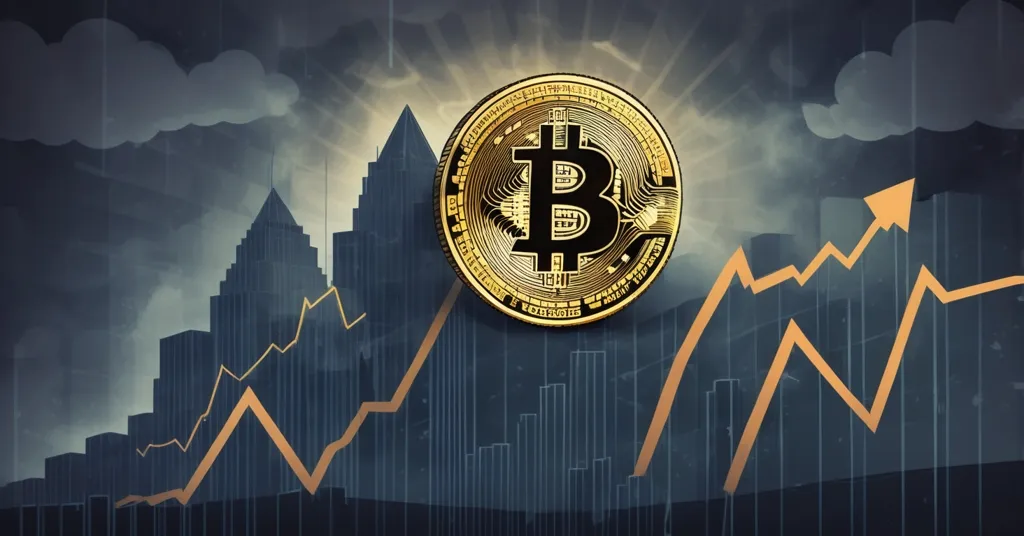Bitcoin Markets Cool as September Fed Rate Cut Odds Fall After Jackson Hole Speech

Bitcoin and Crypto Markets Retreat as September Fed Rate Cut Odds Drop Post-Jackson Hole
Federal Reserve Chairman Jerome Powell had crypto traders riding high with hints of a September rate cut during his Jackson Hole speech last week—until cold, hard data crashed the party. Initially sparking a wave of bullish sentiment for risk assets like Bitcoin, the optimism is now fizzling as market expectations shift ahead of the pivotal Federal Open Market Committee (FOMC) meeting on September 17. Let’s unpack what’s driving this cooldown and why caution might be the smartest play right now.
- Rate Cut Odds Slide: CME Group’s FedWatch tool shows probability of a September cut dropping from 92% to 75%.
- Social Media Hype: Mentions of Fed-related terms hit all-time highs, signaling dangerous euphoria.
- Bitcoin Red Flags: Rising exchange balances hint at profit-taking and potential price corrections.
Fed Rate Cut Odds: From Hype to Hesitation
At the Jackson Hole Economic Symposium, an annual powwow for central bankers and economists, Powell delivered a speech that got crypto bulls salivating. He hinted at easing the Fed’s restrictive monetary policy, pointing to rising downside risks in employment as a reason to consider a rate cut in September. For the uninitiated, lower interest rates mean cheaper borrowing, which often pushes investors to chase higher returns in speculative assets like Bitcoin and altcoins instead of parking cash in safe, low-yield bonds. Markets reacted fast—post-speech, the S&P 500 surged 1.3%, and Treasury yields dipped, signaling bets on looser policy.
But the buzz has taken a hit. The CME Group’s FedWatch tool, a key barometer for predicting Fed moves, now pegs the odds of a September rate cut at 75%, down from a peak of 92% earlier in August. There’s also a 25% chance rates stay unchanged, with no likelihood of a hike. This pullback, even after a brief post-speech spike to 91%, suggests markets are digesting broader economic signals or Powell’s own caution. He stressed a data-dependent approach, meaning no promises—just a wait-and-see stance based on incoming numbers. Key data like the August Consumer Price Index (CPI) and Non-Farm Payrolls, due early September, could make or break the case for a cut. Hotter-than-expected inflation or steady employment might convince the Fed to hold off, drying up the liquidity crypto often thrives on.
Then there’s the Fed’s bigger picture. After years of inflation overshooting their 2% target, they’re stepping back from letting it run hot to balance past shortfalls. Instead, they’re prioritizing preemptive price stability, which could mean shallower cuts even if they start easing. Some economists estimate just a 37% chance of a 75 basis point cut (that’s a 0.75% reduction) by year-end, with a modest 50 basis points more likely for 2024. For crypto investors banking on a flood of cheap money to pump Bitcoin prices, this is a reality check—don’t expect a full-on bull trigger just yet, as detailed in this recent crypto news update.
Market Reactions: Bitcoin and Crypto Under Pressure
While Fed policy sets the macro stage, on-chain signals are flashing warning lights for Bitcoin. Exchange balances—the amount of BTC sitting on platforms like Binance or Coinbase—are climbing. Think of exchanges as digital marketplaces; when more Bitcoin piles up there, it’s often a sign holders are gearing up to sell, potentially cashing in profits. Historically, this precedes price corrections, especially around high-stakes events like the upcoming FOMC decision. If demand doesn’t match the supply hitting the market, a Bitcoin price dip could be on the horizon, as noted in recent data on Bitcoin exchange balances.
Social media isn’t helping cool heads either. Analytics from Santiment show mentions of “fed,” “rate,” and “cut” have hit an all-time high in crypto circles on platforms like X. When every crypto bro turns into a Fed analyst, spamming memes about rate cut moonshots, it’s usually a damn good sell signal. History tells us this kind of euphoria—blind cheerleading detached from fundamentals—often marks a market top. With sentiment this frothy, the rug could get pulled faster than you can say “quantitative easing,” a trend also highlighted in this analysis of Bitcoin’s market reaction.
Altcoin Angles: Opportunity Amid Uncertainty
Bitcoin might be the poster child of crypto, but altcoins like Ethereum and its ecosystem of decentralized finance (DeFi) protocols often react differently to Fed moves. Lower rates historically boost DeFi—think yield farming or staking on platforms like Aave or Curve—because cheap borrowing makes leveraging up for higher returns more attractive. Layer-2 solutions like Arbitrum or Optimism could also see speculative inflows if risk appetite rises with a rate cut. For altcoin enthusiasts, Fed uncertainty isn’t just a hurdle; it’s a chance to snag undervalued projects poised for a liquidity-driven pop.
That said, altcoins are a double-edged sword. They’re often more volatile than Bitcoin, prone to sharper dumps if rate cut hopes fully collapse. Smaller tokens lack BTC’s relative stability as a store-of-value narrative, so any macro disappointment could hit them harder. While Bitcoin maximalists might shrug off Fed drama as validation of a censorship-resistant hedge, altcoin traders need to tread lightly—picking projects with real utility over pure hype is key in choppy waters, a perspective echoed in discussions on how Fed cuts impact Bitcoin prices.
Beyond Economics: Political Wildcards and Crypto’s Edge
Fed policy isn’t the only storm brewing. Political noise adds another layer of uncertainty, with figures like President Trump threatening to meddle in Fed governance—think firing board members or reshaping the FOMC. Powell has pushed back hard, emphasizing the Fed’s independence, but any hint of interference rattles markets. Why? Predictability in monetary policy is a cornerstone of investor confidence. If political games erode that, risk assets like crypto could face sudden sentiment swings, a concern raised in a recent report on Powell’s speech and its crypto implications.
For Bitcoin advocates, this mess is just more fuel for the fire. Centralized systems meddling with money supply is exactly why Satoshi Nakamoto built BTC—a decentralized alternative free from political whims. If Trump or anyone else starts pulling strings at the Fed, it’s another neon sign pointing to Bitcoin’s value proposition. Sure, short-term price action might wobble, but the long game of disrupting outdated financial systems only gets clearer.
What’s Next for Crypto Investors?
With a 75% chance of a rate cut still on the table, the outlook isn’t all doom and gloom—but it’s far from a guaranteed moonshot. The Fed’s cautious, data-driven stance, paired with market euphoria and on-chain sell-off signals, paints a murky picture. Upcoming August inflation and employment data will be make-or-break; hotter numbers could slash cut odds further, while weaker reports might lock in some easing. Add political headwinds, and crypto markets are stuck hating the uncertainty they’re forced to navigate, a sentiment shared in various community discussions on Bitcoin’s price reactions.
For newcomers, a practical tip: don’t chase Fed hype. Use volatility to dollar-cost average into Bitcoin or research altcoins with solid fundamentals, not just buzz. Seasoned hodlers know the drill—zoom out. A delayed cut or shallow easing cycle doesn’t kill the case for decentralization; it strengthens it. If the Fed keeps playing it safe, they might as well mail Bitcoin a thank-you note for exposing their outdated playbook. And here’s a spicy thought to chew on: even if a cut pumps BTC short-term, are we just trading one centralized master for another in whale-driven markets? True freedom doesn’t hinge on Powell’s next soundbite.
Key Takeaways and Questions for Crypto Investors
- How did Jerome Powell’s Jackson Hole speech impact Bitcoin and crypto markets?
Powell hinted at a September rate cut due to employment risks, initially fueling bullish sentiment as lower rates often drive investment into risk assets like cryptocurrencies. - Why are expectations for a September Fed rate cut declining?
The CME Group’s FedWatch tool dropped odds from 92% to 75%, likely due to broader economic data and the Fed’s cautious, data-dependent approach signaling no firm commitment. - What do rising Bitcoin exchange balances mean for prices?
Increased BTC on exchanges often signals profit-taking or selling intent, a historical precursor to price corrections if demand doesn’t keep pace with supply. - Is social media hype about Fed cuts a warning for crypto traders?
Yes, Santiment data shows record-high mentions of Fed terms, suggesting euphoria that typically precedes market tops when optimism outstrips fundamentals. - How do Federal Reserve rate decisions affect Bitcoin and altcoins?
Rate cuts lower borrowing costs, often boosting speculative investments like crypto, while unchanged or higher rates can dampen risk appetite, hitting altcoins especially hard. - What economic data should crypto traders watch before the September 17 FOMC meeting?
August Consumer Price Index (CPI) and Non-Farm Payrolls data are critical; hot inflation or strong jobs numbers could reduce cut odds, cooling crypto sentiment. - Why does Fed independence matter to Bitcoin’s value proposition?
Political threats to Fed autonomy highlight risks of centralized control, reinforcing Bitcoin’s appeal as a decentralized hedge against monetary policy manipulation.



